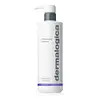What's inside
What's inside
 Key Ingredients
Key Ingredients

No key ingredients
 Benefits
Benefits

 Concerns
Concerns

 Ingredients Side-by-side
Ingredients Side-by-side

Water
Skin ConditioningCetearyl Alcohol
EmollientBisabolol
MaskingZingiber Officinale Root Extract
MaskingLeuconostoc/Radish Root Ferment Filtrate
AntimicrobialGlycerin
HumectantAvena Sativa Kernel Extract
AbrasiveCucumis Sativus Fruit Extract
EmollientRubus Idaeus Fruit Extract
AstringentLavandula Angustifolia Flower Extract
CleansingSalix Alba Bark Extract
AstringentUsnea Barbata Extract
Butylene Glycol
HumectantPentylene Glycol
Skin ConditioningHydroxyphenyl Propamidobenzoic Acid
Skin ConditioningCitrus Medica Limonum Fruit Extract
Skin ConditioningFumaria Officinalis Flower/Leaf/Stem Extract
Skin ConditioningFumaric Acid
BufferingEchinacea Purpurea Extract
MoisturisingPanthenol
Skin ConditioningAcrylates/C10-30 Alkyl Acrylate Crosspolymer
Emulsion StabilisingCocamidopropyl Pg-Dimonium Chloride Phosphate
Disodium Lauryl Sulfosuccinate
CleansingCetrimonium Chloride
AntimicrobialAminomethyl Propanol
BufferingGlyceryl Caprylate
EmollientDisodium EDTA
Water, Cetearyl Alcohol, Bisabolol, Zingiber Officinale Root Extract, Leuconostoc/Radish Root Ferment Filtrate, Glycerin, Avena Sativa Kernel Extract, Cucumis Sativus Fruit Extract, Rubus Idaeus Fruit Extract, Lavandula Angustifolia Flower Extract, Salix Alba Bark Extract, Usnea Barbata Extract, Butylene Glycol, Pentylene Glycol, Hydroxyphenyl Propamidobenzoic Acid, Citrus Medica Limonum Fruit Extract, Fumaria Officinalis Flower/Leaf/Stem Extract, Fumaric Acid, Echinacea Purpurea Extract, Panthenol, Acrylates/C10-30 Alkyl Acrylate Crosspolymer, Cocamidopropyl Pg-Dimonium Chloride Phosphate, Disodium Lauryl Sulfosuccinate, Cetrimonium Chloride, Aminomethyl Propanol, Glyceryl Caprylate, Disodium EDTA
 Reviews
Reviews

Ingredients Explained
These ingredients are found in both products.
Ingredients higher up in an ingredient list are typically present in a larger amount.
Disodium EDTA plays a role in making products more stable by aiding other preservatives.
It is a chelating agent, meaning it neutralizes metal ions that may be found in a product.
Disodium EDTA is a salt of edetic acid and is found to be safe in cosmetic ingredients.
Learn more about Disodium EDTAGlycerin is already naturally found in your skin. It helps moisturize and protect your skin.
A study from 2016 found glycerin to be more effective as a humectant than AHAs and hyaluronic acid.
As a humectant, it helps the skin stay hydrated by pulling moisture to your skin. The low molecular weight of glycerin allows it to pull moisture into the deeper layers of your skin.
Hydrated skin improves your skin barrier; Your skin barrier helps protect against irritants and bacteria.
Glycerin has also been found to have antimicrobial and antiviral properties. Due to these properties, glycerin is often used in wound and burn treatments.
In cosmetics, glycerin is usually derived from plants such as soybean or palm. However, it can also be sourced from animals, such as tallow or animal fat.
This ingredient is organic, colorless, odorless, and non-toxic.
Glycerin is the name for this ingredient in American English. British English uses Glycerol/Glycerine.
Learn more about GlycerinWater. It's the most common cosmetic ingredient of all. You'll usually see it at the top of ingredient lists, meaning that it makes up the largest part of the product.
So why is it so popular? Water most often acts as a solvent - this means that it helps dissolve other ingredients into the formulation.
You'll also recognize water as that liquid we all need to stay alive. If you see this, drink a glass of water. Stay hydrated!
Learn more about Water